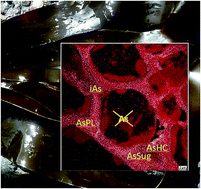Why is NanoSIMS elemental imaging of arsenic in seaweed (Laminaria digitata) important for understanding of arsenic biochemistry in addition to speciation information?†
Abstract
Brown seaweed such as Laminaria digitata is known to accumulate arsenic at a concentration of more than 100 mg kg−1. How the algae can tolerate such a high level of arsenic has traditionally been studied by arsenic speciation analysis using HPLC-ICPMS, but the knowledge of its molecular forms has not yet given any answers. Here we demonstrate for the first time that the combination of speciation analysis with high resolution imaging by NanoSIMS and TEM identifies not only the molecular structures of arsenic but also the location of arsenic in cells and cell substructures in a brown seaweed species. The majority of 117 mg kg−1 arsenic in L. digitata fronds was in the form of inorganic arsenic (53%) and arsenosugars (32%) and only 1.5% of total arsenic as arsenolipids (mainly as AsHC and AsPL). A lateral resolution of 300 nm and the concentration of arsenic were high enough for the localization of arsenic in the cells of the seaweed using NanoSIMS. The majority of arsenic was found in the cell walls and cell membrane, while the inside of the cell was almost arsenic free, which is not expected if the majority of arsenic species are hydrophilic. The NanoSIMS images question the integrity of the arsenic species during extraction for the speciation analysis and indicate that inorganic arsenic is unlikely to occur freely in the seaweed. Whether inorganic arsenic and the arsenosugars are bound directly to the polymeric carbohydrate alginates or fucoidans in the seaweed is unclear and needs further investigation.

- This article is part of the themed collection: SIMS for Biological Applications


 Please wait while we load your content...
Please wait while we load your content...